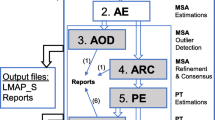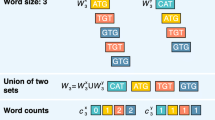Abstract
Large-scale multigene datasets used in phylogenomics and comparative genomics often contain sequence errors inherited from source genomes and transcriptomes. These errors typically manifest as stretches of non-homologous characters and derive from sequencing, assembly, and/or annotation errors. The lack of automatic tools to detect and remove sequence errors leads to the propagation of these errors in large-scale datasets. PREQUAL is a command line tool that identifies and masks regions with non-homologous adjacent characters in sets of unaligned homologous sequences. PREQUAL uses a full probabilistic approach based on pair hidden Markov models. On the front end, PREQUAL is user-friendly and simple to use while also allowing full customization to adjust filtering sensitivity. It is primarily aimed at amino acid sequences but can handle protein-coding nucleotide sequences. PREQUAL is computationally efficient and shows high sensitivity and accuracy. In this chapter, we briefly introduce the motivation for PREQUAL and its underlying methodology, followed by a description of basic and advanced usage, and conclude with some notes and recommendations. PREQUAL fills an important gap in the current bioinformatics tool kit for phylogenomics, contributing toward increased accuracy and reproducibility in future studies.
Access this chapter
Tax calculation will be finalised at checkout
Purchases are for personal use only
Similar content being viewed by others
References
Chatzou M, Floden EW, Di Tommaso P, Gascuel O, Notredame C (2018) Generalized bootstrap supports for phylogenetic analyses of protein sequences incorporating alignment uncertainty. Syst Biol 67(6):997–1009
Philippe H, Brinkmann H, Lavrov DV, Littlewood DTJ, Manuel M, Wörheide G et al (2011) Resolving difficult phylogenetic questions: why more sequences are not enough. PLoS Biol 9(3):e1000602
Irisarri I, Meyer A (2016) The identification of the closest living relative(s) of tetrapods: phylogenomic lessons for resolving short ancient internodes. Syst Biol 65(6):1057–1075
Schneider A, Souvorov A, Sabath N, Landan G, Gonnet GH, Graur D (2009) Estimates of positive Darwinian selection are inflated by errors in sequencing, annotation, and alignment. Genome Biol Evol 1:114–118
Di Franco A, Poujol R, Baurain D, Philippe H (2019) Evaluating the usefulness of alignment filtering methods to reduce the impact of errors on evolutionary inferences. BMC Evol Biol 19(1):21
Whelan S, Irisarri I, Burki F (2018) PREQUAL: detecting non-homologous characters in sets of unaligned homologous sequences. Bioinformatics 34(22):3929–3930
Criscuolo A, Gribaldo S (2010) BMGE (Block Mapping and Gathering with Entropy): a new software for selection of phylogenetic informative regions from multiple sequence alignments. BMC Evol Biol 10(1):210
Capella-Gutiérrez S, Silla-Martínez JM, Gabaldón T (2009) trimAl: a tool for automated alignment trimming in large-scale phylogenetic analyses. Bioinformatics 25(15):1972–1973
Castresana J (2000) Selection of conserved blocks from multiple alignments for their use in phylogenetic analysis. Mol Biol Evol 17(4):540–552
Ali RH, Bogusz M, Whelan S (2019) Identifying clusters of high confidence homologies in multiple sequence alignments. Mol Biol Evol 36(10):2340–2351
Durbin R, Eddy SR, Krogh A, Mitchison GJ (1998) Biological sequence analysis: probabilistic models of proteins and nucleic acids. Cambridge University Press, Cambridge
Wu M, Chatterji S, Eisen JA (2012) Accounting for alignment uncertainty in phylogenomics. PLoS One 7(1):e30288
Bogusz M, Whelan S (2017) Phylogenetic tree estimation with and without alignment: new distance methods and benchmarking. Syst Biol 66(2):218–231
Fletcher W, Yang Z (2009) INDELible: a flexible simulator of biological sequence evolution. Mol Biol Evol 26(8):1879–1888
Whelan NV, Kocot KM, Moroz TP, Mukherjee K, Williams P, Paulay G et al (2017) Ctenophore relationships and their placement as the sister group to all other animals. Nat Ecol Evol 1(11):1737–1746
MacLeod A, Irisarri I, Vences M, Steinfartz S (2015) The complete mitochondrial genomes of the Galápagos iguanas, Amblyrhynchus cristatus and Conolophus subcristatus. Mitochondr DNA Part A 27(5):3699–3700
Burki F, Kaplan M, Tikhonenkov DV, Zlatogursky V, Minh BQ, Radaykina LV et al (2016) Untangling the early diversification of eukaryotes: a phylogenomic study of the evolutionary origins of Centrohelida, Haptophyta and Cryptista. Proc R Soc B-Biol Sci 283(1823):20152802
Tange O (2015) GNU Parallel 20150322 (‘Hellwig’). USENIX Magazine 36:42–47
Köster J, Rahmann S (2012) Snakemake: a scalable bioinformatics workflow engine. Bioinformatics 28(19):2520–2522
Larsson A (2014) AliView: a fast and lightweight alignment viewer and editor for large datasets. Bioinformatics 30(22):3276–3278
Acknowledgments
We would like to thank Kazutaka Katoh for the possibility of contributing this chapter. Max E. Schön provided comments on an earlier version. II acknowledges the support from a Juan de la Cierva-Incorporación postdoctoral fellowship (IJCI-2016-29566) from the Spanish Ministry of Science and Competitiveness (MINECO). This work in the lab of FB is supported by a fellowship from Science for Life Laboratory. SW thanks the Carl Tryggers Stiftelse and Uppsala University for support.
Author information
Authors and Affiliations
Editor information
Editors and Affiliations
Rights and permissions
Copyright information
© 2021 Springer Science+Business Media, LLC, part of Springer Nature
About this protocol
Cite this protocol
Irisarri, I., Burki, F., Whelan, S. (2021). Automated Removal of Non-homologous Sequence Stretches with PREQUAL. In: Katoh, K. (eds) Multiple Sequence Alignment. Methods in Molecular Biology, vol 2231. Humana, New York, NY. https://doi.org/10.1007/978-1-0716-1036-7_10
Download citation
DOI: https://doi.org/10.1007/978-1-0716-1036-7_10
Published:
Publisher Name: Humana, New York, NY
Print ISBN: 978-1-0716-1035-0
Online ISBN: 978-1-0716-1036-7
eBook Packages: Springer Protocols




